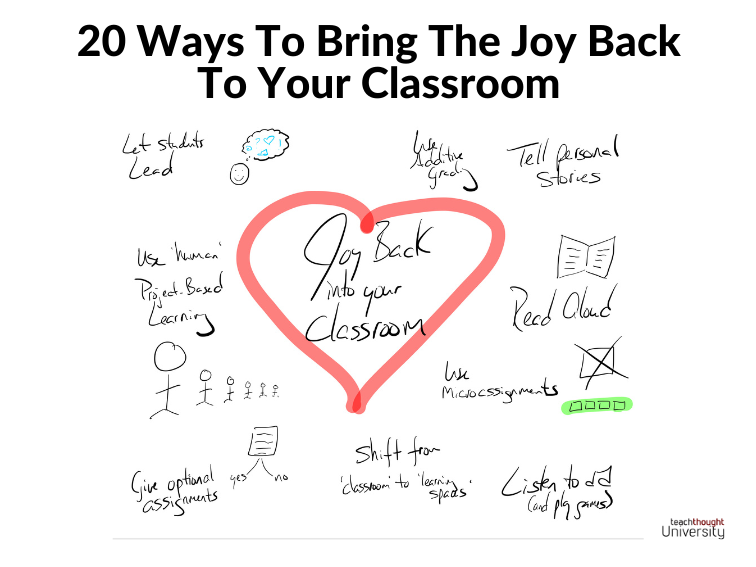How To Bring The Joy Back To Your Classroom
by Terry Heick
Remote teaching and learning have gotten me thinking recently about less about what we teach or even why (two things I tend to think about the most), and more about how we teach (also a critical concept)–which has brought me to the idea of joy.
In a 2014 post, Where Has The Joy Of Learning Gone, neurologist Judy Willis explained, “The truth is that when the joy and comfort are scrubbed from the classroom and replaced with homogeneity and when spontaneity is replaced with conformity, students’ brains are distanced from effective information processing and long-term memory storage.”
So then, the idea of joy in learning. Not joy for the emotional benefits but for the neurological effect and the residual human ‘lifting’ and growth that occurs when emotion and understanding occur together. (See also Why Emotion Is More Important Than Understanding.)
Obviously, there’s a lot more to the idea of ‘joy’ in learning than ‘tips and hacks.’ That said, here are 20 ways that might be useful–in a time of stress, uncertainty, and at times great difficulty–to bring some joy back into your classroom. Many of these apply to remote teaching/remote classrooms as well, but these ideas are intended for teaching in general rather than pandemic-only teaching.
20 Ways To Bring The Joy Back To Your Classroom
1. Let students lead
Empower students–support them and get out of their way. In part, this is the difference of ‘push’ teaching versus ‘pull’ teaching.
Not only are students (generally) more energetic, imaginative, but your role shifts and the dynamic of the classroom itself shifts from a teacher having ‘strong classroom management skills’ to ‘children are engaged and leading their own learning experiences.’ Properly-structured and supported, this can lead to a joyful classroom.
In a remote classroom, this potential depends heavily on lesson and unit design. Letting a 2nd-grader ‘lead’ a Zoom lesson on fractions is takes more than a little imagination. But if you do so–maybe message them before classroom and ask them to each demonstrate a fraction visually using a prop of their choice–at the very least, engagement improves.
2. Use team-building
Community and togetherness and fraternity bring trust and interdependence–and ultimately can lead to joy. Here are some examples of team-building games that promote critical thinking to get you started. I’ll try to find some remote teaching and learning team-building games sometime this week.
3. Be human
Being joyful is a hallmark of being human, so it makes sense that being human can ’cause’ joy. Figuring out what this means to you–in your classroom with your students–is your starting point and then, through ongoing dialogue with students (and recognition what is and is not working), finding out how ‘human’ your classroom should be for students to grow.
The world isn’t perfect and virtual learning environments don’t have to be, either. If something doesn’t work or a dog barks or the PowerPoint won’t upload, it’s frustrating but is also an opportunity to humanize the learning–and learning process.
4. Use ‘human’ project-based learning
Piggy-backing on the concept above, project-based learning moves the learning out of the classroom. It also can shift learning from ‘learn how to calculate the area of a rectangle’ to ‘learning how to calculate the area of a rectangle so you can design urban garden spaces of local, sustainable food sources.’
Using PBL to solve human problems and improve human well-being results in more joy, right?
5. Don’t grade everything
This is something I talk a lot about. Teaching seemed completely overwhelming to me until I figured this out. I’ll write more about this but the idea is reduced teacher workload, which reduces fatigue and allows you to focus more on the parts of the job you love. It also has the secondary benefit of more engaging lessons and units, too.
6. Give optional work
Homework, for example.
Giving more assignments doesn’t seem like it’d lead to ‘joy,’ but the idea is that every student has the opportunity to improve and grow. Whether they want to deepen their understanding of something they’re curious or passionate about or just want to improve their letter grade, optional work is a kind of freedom to grow and can shift the gravity in the classroom from ‘teacher’ to ‘student’ through the gift of choice.
7. Know what each child needs
Some students need teachers, some need champions–and it’s not always easy to know what they need and when.
Learning to ‘ignore the misbehavior’ was a useful classroom management strategy for me during my first few years of teaching. Students are human and make poor decisions at times. Part of good teaching is changing the feedback loops in the classroom.
When a student demonstrates this behavior, this happens. When they demonstrate another, something else happens. By changing those feedback loops, students can move from entertaining the class or protecting their reputation with peers or other ‘misbehaviors’ to listening, asking questions, and (just maybe) improving skills.
Every child is on their own schedule no matter how much you push. Having a big heart and a short memory helps give every child a chance to grow–and a chance to bring joy to your classroom.
8. Teach (and learn) with mindfulness
Among other ideas, mindfulness is about living in the moment with focused awareness on the richness of that moment through the five senses. Research is clear that this lowers anxiety, reduces stress, and improves well-being. If you can not just teach this as a practice but actually use it to teach and learn, your classroom has a chance to be a calmer, happier place.
Consider starting your class with meditation–or even 30 seconds of ‘it’s okay to be quiet’ silence. Then throughout the class, point out opportunities for mindfulness for students: a sound or visual or emotion or smile. Anything that grounds the lesson and helps students begin to appreciate the texture of ‘moments’–even those spent in digital environments.
9. Use microassignments
Quick ‘microassignments’ that isolate individual learning standards and objectives are low-stress for both the student and teacher. They’re also great ways to provide data, useful for additive grading (see below), and are great formative assessment tools, as well.
10. Read Aloud
Everyone loves to be read to, from pre-K students through college. Even adults. Further, this can be done in any content area. Short stories, picture books, quick essays, plays, and more are all useful here. Reading interesting, funny, heart-warming, and otherwise moving ‘things’ aloud is a simple way to bring joy back into your classroom.
11. Honor your own limits
The fact is, you’re nowhere the most significant contributor to your students’ performance in the classroom. In fact, it’s arguable if you’re even in the top 10. This doesn’t change your goal of being the very best teacher you can be but it should relieve you of the burden of ‘saving’ every child. That mindset is rarely sustainable over a career for a teacher.
Instead, honor your limits, then teach like your hair’s on fire (in the very best possible way) and honor the uncertainty that comes with living–and teaching and learning, too.
12. Make your classroom a safe place
To the degree you can, make your classroom safe from bullying and sarcasm and toxicity and internet trolls and pressure and anxiety and again, to the extent you are able–replace those things with books and music and laughter and vulnerability and humility and conversation and growth.
13. Tell personal stories
See #3 above.
Obviously, be careful here. But my middle and high school students loved hearing about my life. That my parents divorced when I was 12 and how hard that was. That I was bullied at times. That I once stole baseball cards as a child and still carry that burden with me to this day. That I play video games and listen to music loud and am terrified of armadillos.
Boundaries are important and oversharing is a real concern. If you’re not sure, don’t share. The idea isn’t to share deeply personal and shadowy secrets. Rather, the goal is to humanize yourself and by sharing stories about your interactions over the years with others, provide a kind of a hopefully healthy and empathetic model for how to view others.
14. Teach students how to have a conversation
One way to bring joy back into your classroom is to teach students how to have a conversation and a big part of this is to teach students to really, truly listen to one another (without simply waiting for your turn to talk and spotting things you disagree with). When people feel heard and understood, they tend to feel safer, more connected, and often willing to work harder for themselves and those around them.
This requires you to practice listening to students. It’s so easy to fall into the teach and control pattern that rather than listening to students, we’re instead listening for opportunities to teach and correct. You’ll never correct anyone to a state of joy.
15. Use the Habits of Mind
You can read What Are The Habits Of Mind? and Strategies For Bringing The Habits Of Mind Into Your Classroom.
16. Listen to music
Music and rhythm have been lifting human beings up since the dawn of time. The quickest way to shift your classroom from a square room to a joyful place is to turn good music up loud enough for the principal to duck their head in the room wondering what all the fuss is about.
Obviously, what you play and how loudly you play it will depend on your classroom management style, the age of the students, and a million other factors. As always, use your best judgment.
17. Shift from ‘classrooms’ to ‘learning spaces’
Use virtual reality field trips. Google Earth. Actual field trips. Even Skyping with people in your local community and around the world. At minimum, help the student work leave the classroom. At best, help students leave the classroom, too. You can read more about these kinds of shifts here in Shifts To Classroom Of The Future.
Whether you’re remote teaching or teaching in a physical classroom, the future of learning is certainly at least some kind of blended, hybrid approach of physical and digital spaces. While this has its challenges, it also has incredible potential. Virtual reality alone can take you and your students almost anywhere. Connections with other communities are cultures are possible. Content can be more engaging. Teacher workload–designed properly–can be reduced.
When the world is the classroom, you’re no longer the sole architect of all learning design. The design and authoring of these experiences shifts from you to students–or at least more in that direction, anyway.
Immersion. Engagement. New workflow. New connections. New content forms. I don’t mean to over-romanticize these ideas. It rarely works out like we hope. But the potential for new learning spaces and dynamics and forms at least represents an opportunity for a different kind of resonance–and hopefully, joy.
18. Consider additive grading
This seems weak compared to some of the others, but embedded in the idea of additive grading is hope. With this alternative to ‘regular’ grading, students have the chance to always be adding to their grade (the letter grade being a source of anxiety for many) rather than risking a ‘bad grade’ and lowering their ‘score.’
Gamification can be useful for some students, too.
19. Be consistent without being predictable
Structure and consistency lead to organization (which leads to learning). But like tropes in storytelling, if they’re overdone, they’re uninteresting, reduce creative tension, and train the brain of students to not expect anything different. Ever.
Defying expectation is a powerful strategy for joy.
20. Use humor
Tell jokes. Laugh at absurdity. Read funny stories, poems, and plays. Find humor in the mundane.
20 Ways To Bring The Joy Back Into Your Teaching

